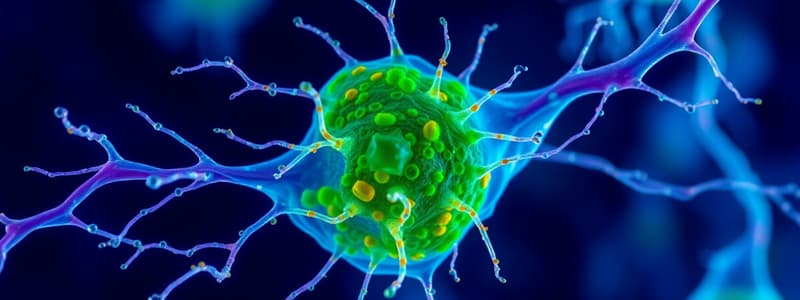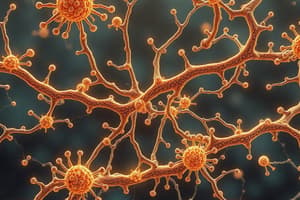Podcast
Questions and Answers
What are the three types of protein filaments that make up the cytoskeleton?
What are the three types of protein filaments that make up the cytoskeleton?
- Intermediate filaments, tubulin, and actin filaments
- Intermediate filaments, microtubules, and actin filaments (correct)
- Microtubules, actin filaments, and collagen
- Actin filaments, myosin, and intermediate filaments
What type of protein subunit do intermediate filaments consist of?
What type of protein subunit do intermediate filaments consist of?
- Transmembrane proteins
- Fibrous proteins (correct)
- Enzymatic proteins
- Globular proteins
What is the primary structural feature of the rod domain in intermediate filament proteins?
What is the primary structural feature of the rod domain in intermediate filament proteins?
- Irregular looped regions
- Coiled-coil structure with loops
- Extended α-helical region (correct)
- Short hydrophobic segments
How do two coiled-coil dimers associate to form a staggered structure?
How do two coiled-coil dimers associate to form a staggered structure?
What characteristic allows intermediate filaments to provide tensile strength?
What characteristic allows intermediate filaments to provide tensile strength?
What happens to tetramers of intermediate filaments after formation?
What happens to tetramers of intermediate filaments after formation?
What is a key property of intermediate filaments compared to microtubules and actin filaments?
What is a key property of intermediate filaments compared to microtubules and actin filaments?
Which of the following correctly describes the formation of the final ropelike structure of intermediate filaments?
Which of the following correctly describes the formation of the final ropelike structure of intermediate filaments?
What is the primary function of microtubules in differentiated animal cells?
What is the primary function of microtubules in differentiated animal cells?
In a nerve cell, which direction do microtubules in the axon point?
In a nerve cell, which direction do microtubules in the axon point?
Which family of motor proteins generally moves toward the plus end of a microtubule?
Which family of motor proteins generally moves toward the plus end of a microtubule?
What determines the type of cargo a motor protein can transport?
What determines the type of cargo a motor protein can transport?
What is a distinguishing feature of motor proteins like kinesins and dyneins?
What is a distinguishing feature of motor proteins like kinesins and dyneins?
What motion do cilia perform?
What motion do cilia perform?
Dyneins primarily move toward which end of a microtubule?
Dyneins primarily move toward which end of a microtubule?
What is a characteristic feature of the interaction between motor proteins and microtubules?
What is a characteristic feature of the interaction between motor proteins and microtubules?
What role do kinesins and dyneins play in cellular function?
What role do kinesins and dyneins play in cellular function?
Which term best describes differentiated animal cells?
Which term best describes differentiated animal cells?
What is the role of the myosin heads during muscle contraction?
What is the role of the myosin heads during muscle contraction?
What triggers muscle contraction at the cellular level?
What triggers muscle contraction at the cellular level?
What structural components are responsible for the sliding filament mechanism in muscle cells?
What structural components are responsible for the sliding filament mechanism in muscle cells?
What is the function of the sarcoplasmic reticulum in muscle cells?
What is the function of the sarcoplasmic reticulum in muscle cells?
Where are the Z discs located in a sarcomere?
Where are the Z discs located in a sarcomere?
What is the role of actin-binding proteins in relation to actin filaments?
What is the role of actin-binding proteins in relation to actin filaments?
Which of the following structures can actin filaments form?
Which of the following structures can actin filaments form?
What is the significance of myosin in relation to actin?
What is the significance of myosin in relation to actin?
What phenomenon describes the addition of actin monomers at the plus end while losing them at the minus end?
What phenomenon describes the addition of actin monomers at the plus end while losing them at the minus end?
What occurs at the plus end of an actin filament during intermediate concentrations of free actin?
What occurs at the plus end of an actin filament during intermediate concentrations of free actin?
Which of the following describes the behavior of naked actin filaments?
Which of the following describes the behavior of naked actin filaments?
What is the effect of ATP hydrolysis on actin filaments?
What is the effect of ATP hydrolysis on actin filaments?
In what type of cellular structures do actin filaments often contribute to contraction?
In what type of cellular structures do actin filaments often contribute to contraction?
What happens at very high concentrations of free actin monomers?
What happens at very high concentrations of free actin monomers?
What type of movement do actin filaments primarily facilitate in cells?
What type of movement do actin filaments primarily facilitate in cells?
What is the primary function of the network of fibrous proteins in human red blood cells?
What is the primary function of the network of fibrous proteins in human red blood cells?
Which process is NOT essential for cell crawling?
Which process is NOT essential for cell crawling?
What role does actin polymerization play in cell crawling?
What role does actin polymerization play in cell crawling?
What is the function of myosin motor proteins during cell movement?
What is the function of myosin motor proteins during cell movement?
Where are new anchorage points established during cell crawling?
Where are new anchorage points established during cell crawling?
What happens to old anchorage points as a cell crawls forward?
What happens to old anchorage points as a cell crawls forward?
Which of the following describes the movement of a crawling cell?
Which of the following describes the movement of a crawling cell?
What type of filaments primarily make up the actin cortex in cells?
What type of filaments primarily make up the actin cortex in cells?
What is the structure of human red blood cells primarily maintained by?
What is the structure of human red blood cells primarily maintained by?
Which event initiates the movement of a cell's front during crawling?
Which event initiates the movement of a cell's front during crawling?
Flashcards are hidden until you start studying
Study Notes
Cytoskeleton Overview
- Composed of three types of protein filaments: intermediate filaments, microtubules, and actin filaments, found in nearly all animal cells.
- Each filament type has unique mechanical properties and is formed from different protein subunits.
Intermediate Filaments
- Provide tensile strength; composed of long strands twisted together.
- Each strand is made of fibrous proteins with a central elongated rod domain and unstructured domains.
- Rod domain contains an extended α-helical region that allows intermediate filament proteins to form stable dimers through coiled-coil configuration.
- Dimer pairs associate to form staggered tetramers, which further combine side-by-side to form the final ropelike structure.
Microtubules
- Organize cell interior and maintain polarity within differentiated cells like nerve cells.
- In neuron axons, all microtubules orient with plus ends toward axon terminals, allowing directional transport of organelles and substances.
- Two families of motor proteins, kinesins and dyneins, facilitate transport along microtubules; kinesins move toward plus ends, while dyneins move toward minus ends.
Motor Proteins
- Composed of dimers with two globular ATP-binding heads and a single tail for cargo binding.
- The heads bind to microtubules directionally, controlling transport directionality.
- Tails attach to various cell components, determining the type of cargo transported.
Cilia and Flagella
- Function in cell movement or fluid movement over cell surfaces; cilia exhibit coordinated whiplike beating.
Actin Filaments
- Interact with various actin-binding proteins for diverse cellular functions, including building stable structures (e.g., microvilli) and facilitating movements (e.g., cell crawling).
- Actin polymerization relies on ATP hydrolysis, leading to a phenomenon known as treadmilling, where monomers add at one end (plus) and disassemble at the other end (minus).
Actin in Human Red Blood Cells
- Fibrous protein networks, including actin and spectrin, support the plasma membrane, maintaining the cell's discoid shape.
Cell Crawling Mechanisms
- Involves coordinated actions: protrusion at the leading edge, adhesion to the substratum, and cell body contraction.
- Actin polymerization pushes the plasma membrane forward, with myosin-mediated contraction drawing the cell forward through traction on anchor points.
Muscle Contraction
- Sarcomeres shorten due to the sliding of actin against myosin filaments, facilitated by myosin heads attaching and detaching.
- This sliding mechanism does not change filament lengths, driving the contraction of muscle cells.
Calcium’s Role in Muscle Contraction
- Muscle contraction is triggered by a rise in cytosolic Ca²⁺, initiated by signals from motor nerves.
- Signals cause action potentials, spreading through transverse (T) tubules and initiating the release of Ca²⁺ from the sarcoplasmic reticulum, crucial for muscle contraction.
Studying That Suits You
Use AI to generate personalized quizzes and flashcards to suit your learning preferences.




